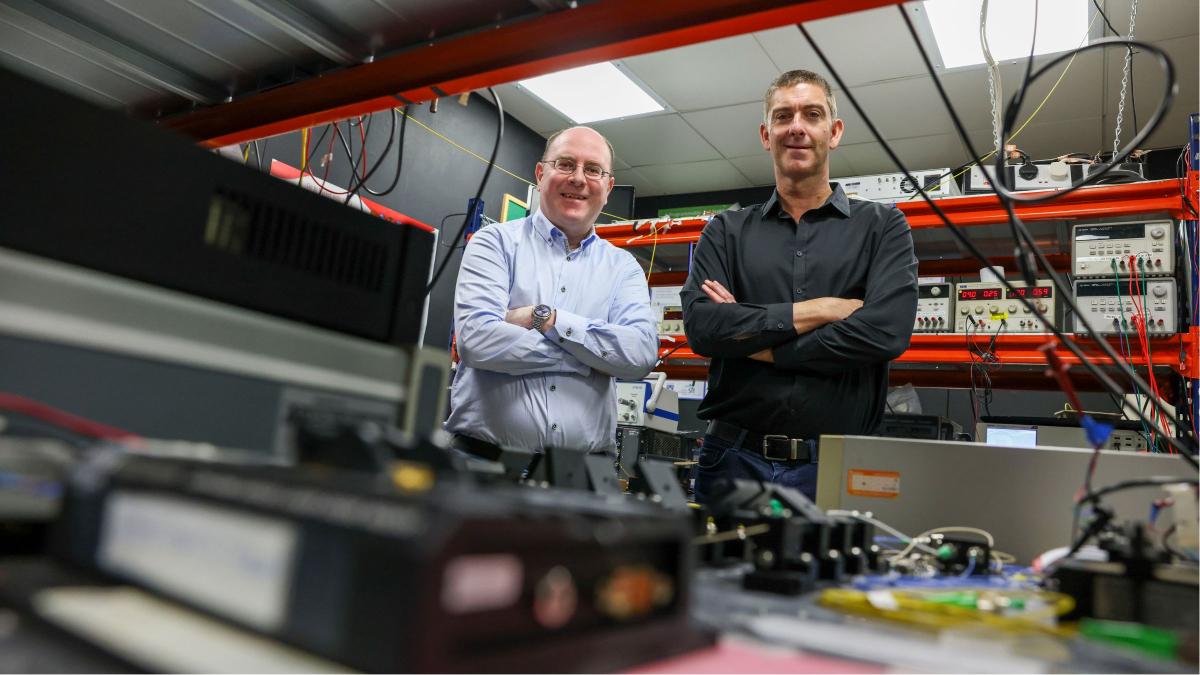

DCU successfully tests laser component of next generation atomic clock for space navigation
Working with Eblana Photonics and Enlightra, the team demonstrated for the first time a new calibre of laser which will allow more efficient and compact implementation of atomic clocks for future satellite missions.
This innovation addresses a key need identified by the European Space Agency, an organisation at the forefront of next generation space navigation systems. The work has recently been published in the Journal of Optics and Laser Technology.
Director of the Laboratory, Prof. Liam Barry said
“The development of optical and photonic technologies will be key to tackle many global challenges in the areas of communication, transport, health, and climate. We are delighted to collaborate on the development of optical sources for the next generation of atomic clocks, that will be key for timekeeping and global positioning.
This project specifically allowed us to develop new laser characterisation facilities which enables us to train future scientists and engineer to better understand these important photonic technologies.”
Many of us struggle to navigate new cities, or even our own, without the help of our smartphones. These devices can help us find our way around with great precision thanks to satellite based navigation systems. This same technology supports all manner of apps on our devices, including social media and dating apps.
These navigation systems, such as Galileo in the European Union and the United States’ Global Positioning System, are reliant on the hyper accurate timekeeping capabilities of microwave atomic clocks and future optical atomic clocks have orders of magnitude improvements on current microwave transition clocks. With the rapidly improving performance of optical clocks, it will only be possible to take full advantage by operating them in space, since on Earth the clock frequency is influenced by the Earth’s gravitational potential at the location of the clock. Therefore, in the future, most applications requiring the highest accuracy will require operating optical clocks sufficiently far away from Earth.
When it comes to navigation the smaller the error in time measurement, the smaller the error in distance obtained. For example, a timing error of a nanosecond or 1 billionth of a second translates into an almost 30-centimetre distance and positional error. Even the best mechanical and electric clocks have inaccuracies of a few seconds per day due to environmental conditions.

By tracking the electromagnetic radiation frequency of electrons as they transition from one energy level to another, scientists are able to keep time with an accuracy to within one second in a few hundred million years. For this reason, atomic clocks now set the length of a second and the time standard for the world. Optical clocks have now achieved a performance significantly beyond that of the best microwave clocks, at levels now below 1×10-17 relative inaccuracy. It is therefore expected that in the near future the unit of time will be redefined via an optical transition.
The new calibre laser, demonstrated successfully for the first time at DCU, will operate in an optical atomic clock using strontium atoms. These atoms, which are smaller than those used in other clocks, are stimulated into energy transitions by the laser, in a process known as optical pumping. The laser developed in this project is smaller and requires less power than previous iterations, which is vital for use on board satellites.
Space based applications place some of the most stringent requirements of the atomic clocks used for timekeeping, requiring exceptional performance in harsh environments. Perhaps the most crucial requirement is low size, weight, and power (SWaP) requirements compatible with use on small satellites. The European Space Agency (ESA) is one of the leading forces pushing forward the technology of next generation space based atomic clocks.
Eblana CEO Jim Somers said
“Eblana expects these innovations to create a new category of products which it believes will add significantly to the company’s bottom line and boost its reputation in the photonics marketplace.”
Eblana Photonics is developing high performance compact laser diodes with European Space Agency (ESA) support, and is keen to add it to the company’s growing catalogue of photonic diodes and devices. “This innovation, which began at wavelengths typical of the telecommunications industry, is now finding a new and exciting home at lower wavelengths that will offer fundamental improvements to ESA’s atomic clock programme,” says Richard Phelan, Eblana Photonics R&D director.
The Radio & Optical Communications Laboratory in the School of Electronic Engineering, DCU, has been developing ground breaking laser technologies for communications and sensing applications for over 25 years.
